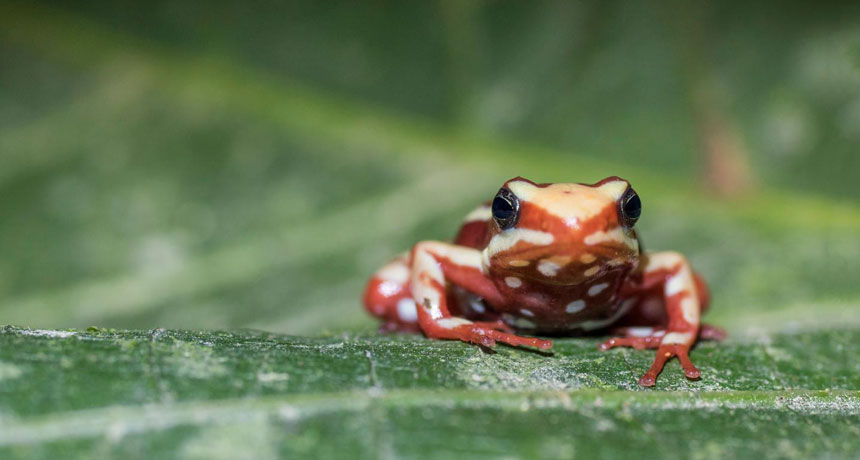How these poison frogs avoid poisoning themselves
They evolved a cascade of several genetic changes

The potent toxin epibatidine was first discovered in 1974 in the skin of the phantasmal poison frog, shown here.
R. TARVIN/UNIVERSITY OF TEXAS AT AUSTIN
Poison dart frogs tend to advertise their toxic nature with a brightly colored skin. The toxic chemical made by those frogs can kill a human. It does not, however, harm the frog. A new study shows that for some frogs, evolving a way to make and use this defensive weapon came with a price.
A genetic change protected one group of frogs from epibatidine (Ep-ih-BAT-ih-deen). It’s a lethal toxin that the frogs derive by recycling some toxic materials in their diet. But the change that keeps the frogs from being poisoned by this chemical also disrupts a key chemical — one that relays messages in its brain. The frogs have managed to sidestep that potentially damaging side effect, however. It required evolving some additional genetic tweaks. Researchers describe what those tweaks are in the September 22 Science.
Other studies had turned up genetic changes that help frogs resist the toxic effects of certain toxins. But this study “lets you look under the hood,” says Butch Brodie. He’s an evolutionary biologist at the University of Virginia in Charlottesville. He wasn’t involved in the research. But with this study, he notes, it’s possible see the full effects of those changes.
Toxic frogs
Many poison dart frogs carry cocktails of toxic alkaloids, a type of chemical, in their skin. It defends them from being eaten by predators. The ingredients to make those toxins are picked up through the frogs’ diet. And the toxin can vary by species. In the new study, researchers studied frogs that carry epibatidine. It’s so potent that just a few millionths of a gram can kill a mouse.
Previous studies have looked at how poisonous frogs became resistant to the toxins they carry. They found that the frogs’ bodies alter the proteins that these toxins bind to. That binding is necessary for the toxin to do its harm. Switching out certain of the protein’s building blocks — or amino acids — changes the shape of that protein. This can prevent toxins from latching onto the protein. But that change, notes Rebecca Tarvin, could have unintended side effects. Tarvin is an evolutionary biologist who worked on this project at the University of Texas at Austin.
Acetylcholine (Ah-SEE-tul-KO-leen) is a chemical messenger important for normal brain function. It works by binding to certain proteins in the brain. Epibatidine binds to the same proteins. And the change that the frogs evolved to guard those proteins from the toxic effects of epibatidine should prevent them from responding correctly to acetylcholine. But it didn’t. To find out why, Tarvin and her colleagues focused on the amino acids that the frogs’ bodies used to build those brain proteins. Such proteins are known as acetylcholine receptors.
The amino acid recipe of those receptors differed between poison frog species that are resistant to epibatidine and close relatives that aren’t.
To see which change mattered most, they worked with the gene from humans that make that receptor. (Humans aren’t resistant to epibatidine.) They put those genes into frog eggs. Then they modified those genes. This involved replacing select amino acids in the human code with substitutions found in poison frogs. That let them home in on a single amino-acid change that protected the receptor from epibatidine.
But that one change wasn’t the end of it, it turned out. “We noticed that replacing one of those amino acids in the human [protein] made it resistant to epibatidine,” explains Cecilia Borghese. She’s a neuropharmacologist at the University of Texas who worked on the project. That change affected how the receptor protein interacted with acetylcholine. Both the toxin and the brain’s messenger chemical bound to the exact same part of the protein. “It’s a very delicate situation,” she notes. While the amino acid change protected the receptor from the frog’s toxin, it also made it harder for acetylcholine to attach.
That should have prevented the brain messenger chemical from doing its job. Yet the frogs seemed fine.
Further research showed why. The amino-acid recipe for the receptor protein differed elsewhere, too. And those extra changes appear to have compensated for any effects of the anti-toxin changes, the researchers found. The result is a protein that won’t let the toxin bind, yet still responds normally to acetylcholine.
Amino-acid changes needed to protect the frogs from this toxin seem to have evolved three separate times in poison frogs, Tarvin says. Three different lines of the animals are immune to the poison. All of them got that immunity by flipping the same switch. But the extra changes that allowed them to still respond normally to acetylcholine differed in the three groups.
It’s “cool”, Brodie says. “These other switches weren’t identical,” he notes, yet achieved the same benefit.
R. Tarvin







